Chapter 7 Kinetic Energy & Work
Learning Objectives:
In this chapter you will basically learn:
\(\bullet\) Learn how a particle’s kinetic energy is a scalar quantity, and are related to mass, and speed.
\(\bullet\) Learn work done on a particle by taking a dot product of the force vector and the displacement vector, in either magnitude-angle or unit-vector notation.
\(\bullet\) Learn the work–kinetic energy theorem to relate the work done by a force (or the net work done by multiple forces) and the resulting change in kinetic energy.
\(\bullet\) Learn the work done by the gravitational force when an object is lifted or lowered.
\(\bullet\) Learn Hooke’s law that applies between the force on an object due to a spring, the stretch or compression of the spring, and the spring constant of the spring.
\(\bullet\) Learn to apply the relationship between average power, the work done by a force, and the time interval in which that work is done.
\(\bullet\) Learn that given the work as a function of time, find the instantaneous power.
\(\bullet\) Learn how to determine the instantaneous power by taking a dot product of the force vector and an object’s velocity vector, in magnitude-angle and unit-vector notations.
7.1 Kinetic Energy:
In Eq. 5-19, we found a quantity K represents the energy of the object gains by its motion and is known as kinetic energy. Thus, Eq. 5-19 states that any work done on point object by an external force goes to increase the object’s kinetic energy.
Assume an object of mass m whose speed v is well below the speed of light, the kinetic energy is given by
\[\begin{equation} K = \frac{1}{2}mv^2 ~~~(kinetic~ energy). \tag{7.1} \end{equation}\]
The SI unit of kinetic energy (and all types of energy) is the joule (J), named for James Prescott Joule, an English scientist of the 1800s and defined as
\[\begin{equation} 1~ joule = 1~ J = 1 ~\frac{kg-m^2}{s^2} \tag{7.2} \end{equation}\]
7.2 Work Done by a Constant Force on an Object:
Work W is energy transferred to or from an object via a force acting on the object. Energy transferred to the object is positive work, and from the object, negative work. Work Done by a constant force \(\vec F\) on a particle by a constant force during displacement \(\vec d\) is
\[\begin{equation} W = Fd\cos\phi=\vec F.\vec d~~~(work, constant force), \tag{7.3} \end{equation}\]
in which \(\phi\) is the constant angle between the directions of \(\vec F\) and \(\vec d\). Only the component of that is along the displacement can do work on the object. When two or more forces act on an object, their net work is the sum of the individual works done by the forces, which is also equal to the work that would be done on the object by the net force \(\vec F_{net}\) of those forces.
7.3 Work and Kinetic Energy:
For a particle, a change \(\Delta K\) in the kinetic energy equals the net work Wdone on the particle:
\[\begin{equation} \Delta K = K_f - K_i = W~~~(work–kinetic~energy~theorem), \tag{7.4} \end{equation}\]
in which \(K_i\) is the initial kinetic energy of the particle and \(K_f\) is the kinetic energy after the work is done.
7.4 Work Done by the Gravitational Force:
The work \(W_g\) done by the gravitational force \(\vec F_g\) on a particle-like object of mass m as the object moves through a displacement \(\vec d\) is given by
\[\begin{equation} W_g = \vec F_g\cdot\vec d= mgd\cos\phi \tag{7.5} \end{equation}\]
in which \(\phi\) is the angle between \(\vec F_g\) and \(\vec d\).
Solved Problems:Kinetic Energy & Work
- [1] A proton (mass m = \(1.67 \times 10^{27}\) kg) is being accelerated along a straight line at \(3.6\times 10^{15} m/s^2\) in a machine. If the proton has an initial speed of \(2.4 \times 10^7\) m/s and travels 3.5 cm, what then is (a) its speed and (b) the increase in its kinetic energy?
Solution:
- \[v=\sqrt{v_0^2+2a(x-x_0)}\]
\[v=\sqrt{(2.4 \times 10^7 m/s)^2+2\times3.6\times 10^{15} m/s^2\times (3.5\times 10^{-2}m)}\] \[v=\sqrt{5.76\times 10^{14}+2.52\times 10^{14}}=2.877\times 10^7\space m/s\space (Answer)\]
- \[\Delta K = \frac{1}{2}mv_f^2-\frac{1}{2}mv_i^2=\frac{1}{2}m[v_f^2-v_i^2]\] \[\Delta K =\frac{1}{2}\times1.67 \times 10^{27}kg[(2.88\times 10^7\space m/s)^2-(2.40 \times 10^7\times m/s)^2]\]
\[\Delta K = \frac{2.1 \times 10^{-13}\space J}{1.6\times 10^{-19}}J/eV=1.31\times 10^6\space eV = 1.31\space MeV\space (Answer)\]
- [3] On August 10, 1972, a large meteorite skipped across the atmosphere above the western United States and western Canada, much like a stone skipped across water.The accompanying fireball was so bright that it could be seen in the daytime sky and was brighter than the usual meteorite trail. The meteorite’s mass was about \(4\times10^6\) kg; its speed was about 15 km/s. Had it entered the atmosphere vertically, it would have hit Earth’s surface with about the same speed. (a) Calculate the meteorite’s loss of kinetic energy (in joules) that would have been associated with the vertical impact. (b) Express the energy as a multiple of the explosive energy of 1 megaton of TNT, which is \(4.2 \times 10^{15}\) J. (c) The energy associated with the atomic bomb explosion over Hiroshima was equivalent to 13 kilotons of TNT. To how many Hiroshima bombs would the meteorite impact have been equivalent?
Solution: (a) Meteor’s loss of kinetic energy after impact, \[\Delta K= \frac{1}{2}mv_f^2-\frac{1}{2}mv_i^2=0-\frac{1}{2}(4.0\times 10^6\space kg)(15\times 10^3\space m/s)^2 = -4.5\times 10^{14}\space J\] \[|\Delta K|=|-4.5\times 10^{14}\space J|=4.5\times 10^{14}\space J\space (Answer)\] (b) In terms of megaton, \[|\Delta K|=(4.5\times 10^{14}\space J)\frac{1\space megaton ~of~ TNT}{4.2\times 10^{15}J}=0.107\space megaton\space(Answer)\]
- Number of Hiroshima bombs is equal to
\[n=\frac{0.107}{13\times 10^{-3}}\approx 8\space bombs\space(Answer)\]
- [5] A father racing his son has half the kinetic energy of the son, who has half the mass of the father.The father speeds up by 1.0 m/s and then has the same kinetic energy as the son.What are the original speeds of (a) the father and (b) the son?
Solution:
- Given father has half the kinetic energy of the son, \[K_{father}=\frac{K_{son}}{2}\] \[\frac{1}{2}m_{father}v^2=\frac{1}{2}m_{son}v'^2\]now using the, given mass of son and father \[m_{son}=\frac{m_{father}}{2}\] \[\frac{1}{2}m_{father}v^2=\frac{1}{2}\frac{1}{2}m_{father}(v+1~m/s)^2\] we get, \[\frac{1}{2}v^2-v-\frac{1}{2}=0\] This is a quadratic equation similar to \(ax^2+bx+c=0\), where \(a=\frac{1}{2}\), \(b = -1\) and \(c = -\frac{1}{2}\). The roots are \[v=\frac{1\pm \sqrt{1-4(\frac{1}{2})(-\frac{1}{2})}}{2(\frac{1}{2})}1\pm\sqrt{2}\] Taking only positive root, we get the original speed of father, \[v=2.414~m/s\space (Answer)\]
- \[K_{father}=\frac{K_{son}}{2}\]
\[\frac{1}{2}m_{father}v^2=\frac{1}{2}m_{son}v'^2\] now using the, given mass of son and father \[m_{son}=\frac{m_{father}}{2}\] \[\frac{1}{2}m_{father}v^2=\frac{1}{2}\frac{1}{2}m_{son}v'^2\] \[(\frac{1}{2})(2)m_{son}v^2=\frac{1}{2}\frac{1}{2}m_{son}v'^2\] Son’s original speed was, \[v'=2v=2(2.4\space m/s)=4.8\space m/s\space(Answer)\]
- [8] A ice block floating in a river is pushed through a displacement \(\vec d = (15~m)\hat i-(12~m)\hat j\) along a straight embankment by rushing water, which exerts a force \(\vec F = (210~N)\hat i-(150~m)\hat j\) on the block. How much work does the force do on the block during the displacement?
Solution:
\[W=\vec F\cdot\vec d = (\vec F = (210~N)\hat i-(150~m)\hat j)\cdot ((15~m)\hat i-(12~m)\hat j)= (3150+2250)\space J= 4950\space J\space (Answer)\]
- [14] Figure 7-27 shows an overhead view of three horizontal forces acting on a cargo canister that was initially stationary but now moves across a frictionless floor. The force magnitudes are \(F_1\) = 3.00 N, \(F_2\) = 4.00 N, and \(F_3\) = 10.0 N, and the indicated angles are \(\theta_2 = 50.0^\circ\) and \(\theta_3 = 35.0^\circ\). What is the net work done on the canister by the three forces during the first 4.00 m of displacement?
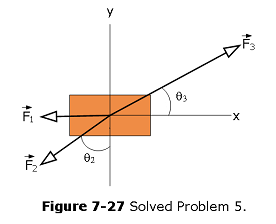
Solution:
\[F_{net,x}=-F_1-F_2\sin\theta_2+F_3\cos\theta_3\] \[F_{net,x}=-3.00\space N-(4.00\space N)\sin50^\circ+10\space N\cos35^\circ=2.13\space N\] \[F_{net,y}=0-(4.00\space N)\cos50^\circ+10\space N\sin35^\circ=2.13\space N=3.16\space N\] \[F_{net}=\sqrt{(F_{net,x})^2+(F_{net,y})^2}=\sqrt{(2.13\space N)^2+(3.16\space N)^2}=3.81\space N\] Work done \[W=Fd=(3.81\space N)(4.00\space m)=15.2\space J\space(Answer)\]
- [15] Figure 7-28 shows three forces applied to a trunk that moves leftward by 3.00 m over a frictionless floor. The force magnitudes are \(F_1\) = 5.00 N, \(F_2\) = 9.00 N, and \(F_3\) = 3.00 N, and the indicated angle is \(\theta = 60.0^\circ\). During the displacement, (a) what is the net work done on the trunk by the three forces and (b) does the kinetic energy of the trunk increase or decrease?
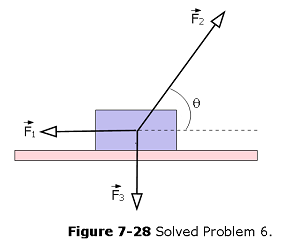
Solution:
Since trunk is sitting on a frictionless floor, we need to redraw the figure to consider two other forces, normal force acting normal to the surface \(\vec F_N\) and the weight of the trunk due to gravity acting downward \(\vec F_g\).
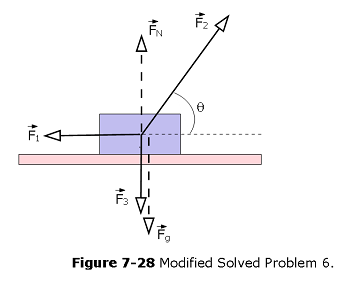
However, vertical forces \(\vec F_2\), \(\vec F_N\) and \(\vec F_g\) will have no effect in work since there is acceleration along the vertical direction. That is,
Using Newton’s second law: \(\vec F_{net}=m\vec a\), we get \[F_{net,x}=ma_x\] \[-F_1+F_2\cos\theta=ma_x\] \[F_{net,y}=m(0)\] \[F_2\sin\theta+F_N-F_3-F_g=0\] (a) \[W_1=\vec F_1\cdot \vec d\]
\[W_1=\hat i F_1\cdot (-\hat i d)=F_1d=(5.00\space N)(3.00\space m)=15.00\space J\] \[W_2=\vec F_2\cdot \vec d\]
\[W_2=(\hat i F_2\cos\theta+(\hat j F_2\sin\theta)\cdot (-\hat i d)=-F_2d\cos\theta=-(9.00\space N)(3.00\space m)\cos60^\circ=-13.50\space J\] \[W_3=(-\hat j F_3-\hat j F_g+\hat j F_N)\cdot (-\hat i d)=0\] Total work done, \[W=W_1+W_2+W_3= (15.00-13.50+0)=1.5\space J\space (Answer)\]
- A change \(\Delta K\) in the kinetic energy equals the net work W done on the particle: \(\Delta K = K_f-Ki = W\) (work–kinetic energy theorem).Net work done is positive as a result kinectic energy increases.
- [18] (a) In 1975 the roof of Montreal’s Velodrome, with a weight of 360 kN,was lifted by 10 cm so that it could be centered. How much work was done on the roof by the forces making the lift? (b) In 1960 a Tampa, Florida, mother reportedly raised one end of a car that had fallen onto her son when a jack failed. If her panic lift effectively raised 4000 N (about of the car’s weight) by 5.0 cm, how much work did her force do on the car?
Solution:
\[W=\vec F\cdot\vec d= Fd\cos0^\circ=(360\times 10^3\space N)(10\times 10^{-2}\space m)=36000\space J\]
\[W=\vec F\cdot\vec d= Fd\cos0^\circ=(4000\space N)(5\times 10^{-2}\space m)=200\space J\]
- [25] In Fig. 7-34, a 0.250 kg block of cheese lies on the floor of a 900 kg elevator cab that is being pulled upward by a cable through distance \(d_1\) = 2.40 m and then through distance \(d_2\) = 10.5 m. (a) Through \(d_1\), if the normal force on the block from the floor has constant magnitude \(F_N\) = 3.00 N, how much work is done on the cab by the force from the cable? (b) Through \(d_2\), if the work done on the cab by the (constant) force from the cable is 92.61 kJ, what is the magnitude of \(F_N\)?
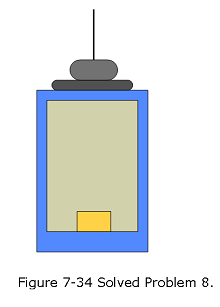
Solution:
- \[T+F_N-(M+m)g=(M+m)a\] On the cheese block: \[F_N-mg=ma\] \[a=\frac{F_N-mg}{m}=\frac{3\space N-(0.250\space kg)9.80\space m/s^2)}{0.25\space kg}=2.2\space m/s^2\] \[T=(M+m)g+(M+m)a-F_N\] \[T=(900\space kg+0.250\space kg)(2.2\space m/s^2)+(900\space kg+0.250\space kg)(9.8\space m/s^2)-3\space N = 10800\space N\] Work done on the cab by the force from the cable is: \[W=Td_1=(10800\space N)(2.4\space m)=25.92\space kJ\space(Answer)\]
- \[F_N-(M+m)g=-\frac{W}{d_2}\] \[F_N=(M+m)g-\frac{W}{d_2}=(900\space kg+0.25\space kg)(9.8\space m/s^2)-\frac{(92.61\times 10^3\space J)}{10.5\space m}=2.45\space N\space(Answer)\]
- [27] A spring and block are in the arrangement of Fig. 7-10. When the block is pulled out to x = +4.0 cm, we must apply a force of magnitude 360 N to hold it there. We pull the block to x = 11 cm and then release it. How much work does the spring do on the block as the block moves from \(x_i\) = +5.0 cm to (a) x = +3.0 cm, (b) x = -3.0 cm, (c) x = -5.0 cm,and (d) x =-9.0 cm?
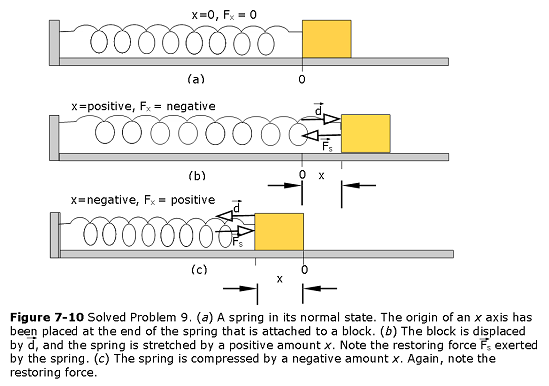
Solution:
\[F = -kx\] \[k=|-\frac{F}{x}|=|-\frac{360\space N}{4\times 10^{-2}}|=9000\space N/m\] (a) Given x_i = 5 cm and x_f = 3 cm. Work done by the given spring with spring constant of 9000 N/m, we get
\[W =\frac{1}{2}k[x_i^2-x_f^2]=\frac{1}{2}(9000\space N/m[(5\times 10^{-2}\space m)^2-(3\times 10^{-2}\space m)^2]= 7.2\space J\space (Answer)\] (b) Given x_i = 5 cm and x_f = -3 cm. Work done by the given spring with spring constant of 9000 N/m, we get
\[W =\frac{1}{2}k[x_i^2-x_f^2]=\frac{1}{2}(9000\space N/m[(5\times 10^{-2}\space m)^2-(-3\times 10^{-2}\space m)^2]= 7.2\space J\space (Answer)\] (c) Given x_i = 5 cm and x_f = -5 cm. Work done by the given spring with spring constant of 9000 N/m, we get
\[W =\frac{1}{2}k[x_i^2-x_f^2]=\frac{1}{2}(9000\space N/m[(5\times 10^{-2}\space m)^2-(-5\times 10^{-2}\space m)^2]= 0\space J\space (Answer)\] (d) Given x_i = 5 cm and x_f = -9 cm. Work done by the given spring with spring constant of 9000 N/m, we get
\[W =\frac{1}{2}k[x_i^2-x_f^2]=\frac{1}{2}(9000\space N/m[(5\times 10^{-2}\space m)^2-(-9\times 10^{-2}\space m)^2]= =25.2\space J\space (Answer)\]
- [43] A force of 5.0 N acts on a 15 kg body initially at rest. Compute the work done by the force in (a) the first, (b) the second, and (c) the third seconds and (d) the instantaneous power due to the force at the end of the third second.
_Solution:__
\[W = Fd\], now using \[d=x - x_{0} = v_{0}t + \frac{1}{2}at^{2}=\frac{1}{2}at^{2}\], we get \[W_1 = F\frac{1}{2}at_1^{2}=(5\space N)(1/2)(1/3\space m/s^2)(1\space s)^2=0.83\space J(Answer)\]
\[W_2 = \frac{1}{2}at_2^{2}-W_1\], we get \[W = F\frac{1}{2}at^{2}-0.83\space J=(5\space N)(1/2)(1/3\space m/s^2)(2\space s)^2-0.83\space J=(3.33-0.83)J=2.50\space J(Answer)\]
\[W_3 = \frac{1}{2}at_3^{2}-\frac{1}{2}at_2^{2}\], we get \[W_3 = (5\space N)(1/2)(1/3\space m/s^2)(3\space s)^2-(5\space N)(1/2)(1/3\space m/s^2)(2\space s)^2=(7.50-3.33)J=4.17\space J(Answer)\]
\[P=Fv=Fat=(5.0\space N)(\frac{1}{3}\space m/s^2)(3\space s)= 5.0\space W(Answer)\]
Problem:Kinetic Energy & Work
Section 7-1 Kinetic Energy
[2] If a Saturn V rocket with an Apollo spacecraft attached had a combined mass of \(2.9 \times 10^5\) kg and reached a speed of 11.2 km/s, how much kinetic energy would it then have?
[4] An explosion at ground level leaves a crater with a diameter that is proportional to the energy of the explosion raised to the power; an explosion of 1 megaton of TNT leaves a crater with a 1 km diameter. Below Lake Huron in Michigan there appears to be an ancient impact crater with a 50 km diameter. What was the kinetic energy associated with that impact, in terms of (a) megatons of TNT (1 megaton yields \(4.2 \times 10^{15}\) J) and (b) Hiroshima bomb equivalents (13 kilotons of TNT each)? (Ancient meteorite or comet impacts may have significantly altered the climate, killing off the dinosaurs and other life-forms.)
Section 7-2 Work and Kinetic Energy
[7] A 3.0 kg body is at rest on a frictionless horizontal air track when a constant horizontal force \(\vec F\) acting in the positive direction of an x axis along the track is applied to the body. A stroboscopic graph of the position of the body as it slides to the right is shown in Fig. 7-25. The force \(\vec F\) is applied to the body at t = 0, and the graph records the position of the body at 0.50 s intervals. How much work is done on the body by the applied force \(\vec F\) between t = 0 and t = 2.0 s?
[16] An 8.0 kg object is moving in the positive direction of an x axis. When it passes through x = 0, a constant force directed along the axis begins to act on it. Figure 7-29 gives its kinetic energy K versus position x as it moves from x = 0 to x = 5.0 m; \(K_0\) = 30.0 J. The force continues to act. What is v when the object moves back through x = -3.0 m?
Section 7-3 Work Done by the Gravitational Force
[17] A helicopter lifts a 72 kg astronaut 15 m vertically from the ocean by means of a cable. The acceleration of the astronaut is g/10. How much work is done on the astronaut by (a) the force from the helicopter and (b) the gravitational force on her? Just before she reaches the helicopter, what are her (c) kinetic energy and (d) speed?
[24] In Fig. 7-33, a horizontal force \(\vec F_a\) of magnitude 20.0 N is applied to a 3.00 kg psychology book as the book slides a distance d = 0.500 m up a frictionless ramp at angle \(\theta = 30^\circ\). (a) During the displacement, what is the net work done on the book by \(\vec F_a\), the gravitational force on the book, and the normal force on the book? (b) If the book has zero kinetic energy at the start of the displacement, what is its speed at the end of the displacement?
Section 7-4 Work Done by a Spring Force
[26] In Fig. 7-10, we must apply a force of magnitude 80 N to hold the block stationary at x = -2.0 cm. From that position, we then slowly move the block so that our force does +4.0 J of work on the spring–block system; the block is then again stationary.What is the block’s position? (Hint:There are two answers.)
[30] In Fig. 7-10a, a block of mass m lies on a horizontal frictionless surface and is attached to one end of a horizontal spring (spring constant k) whose other end is fixed. The block is initially at rest at the position where the spring is unstretched (x = 0) when a constant horizontal force \(\vec F\) in the positive direction of the x axis is applied to it. A plot of the resulting kinetic energy of the block versus its position x is shown in Fig. 7-36. The scale of the figure’s vertical axis is set by \(K_s\) = 4.0 J. (a) What is the magnitude of \(\vec F\)? (b) What is the value of k?
Section 7-5 Work Done by a General Variable Force
[37] Figure 7-40 gives the acceleration of a 2.00 kg particle as an applied force F moves it from rest along an x axis from x = 0 to x = 9.0 m. The scale of the figure’s vertical axis is set by as 6.0 \(m/s^2\). How much work has the force done on the particle when the particle reaches (a) x = 4.0 m, (b) x = 7.0 m, and (c) x = 9.0 m? What is the particle’s speed and direction of travel when it reaches (d) x = 4.0 m,(e) x = 7.0 m,and (f) x = 9.0 m?
[39] A force acts on a particle as the particle moves along an x axis, with in newtons, x in meters, and c a constant.At x = 0, the particle’s kinetic energy is 20.0 J; at x = 3.00 m, it is 11.0 J. Find c.
[40] A can of sardines is made to move along an x axis from x = 0.25 m to x = 1.25 m by a force with a magnitude given by \(F = exp(-4x^2)\), with x in meters and F in newtons. (Here exp is the exponential function.) How much work is done on the can by the force?
Section 7-6 Power
- [44] A skier is pulled by a towrope up a frictionless ski slope that makes an angle of 12( with the horizontal. The rope moves parallel to the slope with a constant speed of 1.0 m/s. The force of the rope does 900 J of work on the skier as the skier moves a distance of 8.0 m up the incline. (a) If the rope moved with a constant speed of 2.0 m/s, how much work would the force of the rope do on the skier as the skier moved a distance of 8.0 m up the incline? At what rate is the force of the rope doing work on the skier when the rope moves with a speed of (b) 1.0 m/s and (c) 2.0 m/s?